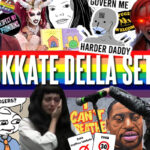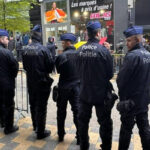Could it be that what is the flagship of woke entertainment has had the distribution of a movie steeped in Catholic values snatched away from it? Well, in the age when faith in Christ appears to be back in the catacombs, it seems so. After all, Netflix precisely out of an eagerness for "diversity" has begun to enlist directors, screenwriters and movies even outside the confines of the Anglosphere, thus, however, bringing in products that end up not always beingaligned with the liberal ideology of the Californian corporation.
The horror movie - subgenre survival -Bird Box Barcellona is a spin-off of a 2018 film released last July 14. Film totally in line with Wokeist stereotypes (single mothers, racial quotas, LGBT friendly etc.). The two director-screenwriters of the Catalan version - Álex Pastor and David Pastor - rewrote the story by setting it in Barcelona. And above all by giving it a subtly Catholic slant, in the deepest sense of the word.
In broad strokes, Bird Box's original topic deals with mysterious invisible entities that appear out of nowhere and trigger an apocalyptic suicide epidemic: those who watch the entities lose their minds and kill themselves. The only way to survive is to blind one's eyesight. The two Pastors maintain this element (the weakest part of the plot, by the way), but deftly add to it a subtext perceptible only to those who know how to read it: what if these entities are the Devil? What if the key to survival is faith in the Almighty God? None of this is ever openly stated. On the contrary, throughout the film the explanations of the various characters are perfectly materialistic, mainstream. Invisible creatures are aliens, quantum forces, psychoanalytic trauma... Yet...
The plot [warning, there are spoilers from here on] is about a man, Sebastian, who travels through a post-apocalyptic Barcelona with his daughter Anna. It soon turns out that Sebastian not only does not intend to escape the "entities," but collaborates with them. Through deception he pushes people he meets to death. He is convinced that he is acting for a "greater good," guided and advised by the words of his daughter Anna, who is actually dead, and whom he imagines in his own head. Sebastian is driven by that vision to make as many people die as possible, to "free their souls."
Sebastian in fact has joined a cult led by a priest with no more faith. This sect has a barred eye as its symbol and hunts down survivors. However, all of a sudden Sebastian encounters a group of survivors of which a lonely little German girl is a member. The man causes the death of most of the members of the group, but when confronted with the little girl he has a jolt of consciousness and regains lucidity. In the final confrontation with the evil priest, Sebastian sacrifices himself to enable the little girl Sofia and coprotagonist Claire to reach the last safe haven where the Barcelonians seem to have organized themselves to resist and prepare for revenge.
If the plot thus told sounds like that of any survival horror film, it is in the details that the Devil must be sought. First of all, the woke elements are dismissed by the two Pastors in the first ten minutes of the film, evidently to make the producers happy. There is the gay character (an extra), there is the black character (the co-star, who is not an immigrant, however, but an African-American writer on a business trip to Spain). There is also the seemingly anti-traditional bullshit: the vilain is Anna's Catholic school chaplain, who loses his faith and founds a Gnostic sect; two of the "good guys" are divorced anti-Frankist intellectuals, with her a feminist. Enough to make some superficial critics foolish and happy.
And it is in the character of the priest devoted to evil that we find the Ariadne's thread that leads us to the Catholic reading of the film. In a delirium of his own, the priest reveals the reasons for choosing evil: faith means believing in what is invisible, but he needs to see. The jibe at the Gnosticism and materialism that are ravaging progressive Catholicism is obvious. One could also see in it the metaphor of the "Mystery of Iniquity," that prophecy of the Church being perverted from within on the eve of the end of time.
At this point, even the malign action of the invisible creatures that drive people to commit suicide acquires a completely different explanation. So much for aliens or Freudian psychoanalysis: they are Satan, who acts through the mortal sin of Despair (a sin against the Holy Spirit, because one loses his trust in the Divine Providence) or by blandishments, wishful thinking and the proposal of an "easy way" to the end of tribulations. Or even by pretending to be angels (the seraphim theme returns several times, and according to one tradition Lucifer was a seraphim before the Fall). Sebastian himself is driven to evil deceived in the belief that he is acting according to a "higher will." Yet, the man already has doubts: he cheats, he betrays. In one scene Sebastian reveals his qualms of conscience by confiding them to an empty confessional. The superficial viewer would say "ah, how pathetic, a bigot..." when in fact that is the seed of redemption: the Sacrament of Penance...
It is in the final confrontation that the Catholic key is revealed. Sebastian sacrifices himself so that the little girl and the American writer can reach salvation. After all, St. Sebastian is invoked as the savior of the persecuted... In the scene of the fight against the evil priest, the ghost of his daughter Anna appears before Sebastian to lead him back into temptation, but she is symbolically enveloped in hellish flames. The man saves himself from falling back into mistake by praising a Gospel passage, "Beware of false prophets, who come to you in sheep's clothing, but inwardly they are ravening wolves." (Matthew 7:15). Grabbed to the faith he fights as a true miles Christi, immolating himself for the sake of the people he has decided to protect, ending up pierced like his eponymous ("Majórem hac dilectiónem nemo habet, ut ánimam suam ponat quis pro amícis suis," Jn. 15:13).
Instead, the element that announces salvation for the two women is the tolling of a bell (a transparent metaphor for the calling of the believers to the Holy Mass) and then the faint tinkling of a pendant (a transparent metaphor for the ringing at the consecration of the Eucharist). And not coincidentally to prevent Claire and Sofia from being saved, the unseen entities go on a rampage with a series of manifestations that would not have disfigured in "The Exorcist": the demon powerless before the souls he cannot capture flails discomposedly as Catholic tradition has told us in a hundred and one stories of defeated possession.
The ending deserves a nod. Sofia and Claire reach Montjuïc Castle in Barcelona where human resistance has organized. The few remaining survivors are organized militarily and harshly disciplined: it is the price of survival. An icy scientist subjects Claire to medical examinations and interrogations and explains her that they are searching for some sort of "vaccine" for these invisible creatures, using as a human guinea pig a suicidal mad captive kept immobilized. In the final scene yet another experiment fails as the possessed (we can now call him so) cries out that the devil of his hallucinations is "beautiful." Materialism will not be able to defeat evil and the road taken is a dead end.
In this film, even the sidekicks provide pearls of nonconformity. Textbook is the exchange of banter between pro-Republicans and pro-Frankists: "This shelter has resisted the bombs of the fascists, we count on resisting in here too"; "Someone explain to the professress who won the war in the end...." As the two divorced intellectuals die together confessing that they never really wanted the separation, driven by anger, incontinence and ... lawyers, "Let man not divide on earth what God has united in heaven."
For decades, mainstream cinema has given up bringing Christian values to the big screen. On the contrary, it has been actively engaged in the de-Christianization of society, with banal anti-Christian scripts and stereotypes. The days of endings with Christian morals - perhaps a bit didactic - as in "The War of the Worlds" (1952) or "Forbidden Planet" (1956) - are another aeon. Today real Catholics have returned to the catacombs. They have to hide, probably from their own "pastors" (as Sebastian calls himself before redeeming himself). But sometimes they manage to re-emerge to have something to say about a world falling apart.
Editor of the Machiavelli Study Center's blog "Belfablog," Emanuele Mastrangelo has been editor-in-chief of "Storia in Rete" since 2006. A military-historical cartographer, he is the author of several books (with Enrico Petrucci, Iconoclastia. La pazzia contagiosa della cancel culture che sta distruggendo la nostra storia e Wikipedia. L'enciclopedia libera e l'egemonia dell'informazione).









Scrivi un commento